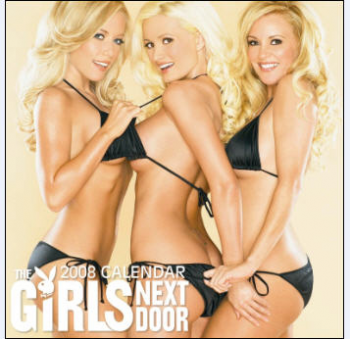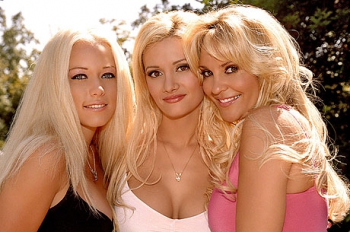Playboy Feminism? Hugh Hefner and The Girls Next Door

The girls of Girls Next Door
Right-wing websites have condemned E!’s reality show, The Girls Next Door, for “normalizing pornography,” destroying marriage and seducing children. Other likeminded forums (such as Free Republic) present a variety of marginally different viewpoints condemning the show, mocking Hugh Hefner as alternately the worst kind of libertine or assailing him as asexual and his magazine as insufficiently erotic.
These screeds hardly mesh with the show, which centers not on male sexual potency but female friendships, desires and the minutiae of Hefner’s girlfriends’ everyday life. Despite its success in winning over female viewers, Girls plays with significant ideological contradictions as it tries to address the prevailing popularity of the Playboy bunny image with a new generation of women while trying to remove any taint of sexual exploitation from its girls.
At least superficially, the girls are what one might expect — buxom, scantily clad platinum blondes. Each is carefully distinguished in several ways, most crudely by her rank that combines her longevity with the seriousness of her relationship with Hef. Girlfriend number one, Holly, is the most serious and maternal, fond of strangely retro pearls and argyle sweaters or micro miniskirts and revealing cocktail dresses. Bridget, girlfriend number two, is an ersatz 1960s sex-kitten who is studying for her second M.A. Like Holly, she knows Playboy’s history, the rules of the bunny dress, stance, and bunny dip and hopes to embody the soft retro-femininity and self-reliant, public womanhood incarnated in either the older Playboy bunnies, or, possibly, in later reworkings of these images. Kendra rounds out the trio, presenting a more contemporary incarnation of the Playboy pin-up. She is all surface, an embodiment of the most standardized male fantasies, the girl we are supposed to laugh at, not identify with.
Kendra’s superficiality and her lack of interest in Playboy’s past helps foreground the show’s own historical discourse around women which sees these earlier bunnies as a contested but noteworthy advance in feminine life. The show plays with the possibilities inherent in this older Playboy image where women are at the center of a glamorous world and men are accessories, playing with it as a locus of both feminist and feminine empowerment in contrast to today’s more superficial sex objects. In contrast, current centerfolds are presented as synthetic, easily substitutable and banal (like Kendra). Holly and Bridget’s oddly mannered and costumed presence speaks to their efforts to forge their own identities through nostalgic reappropriations of Playboy’s latent nuggets of feminine possibility, and significantly, both girls also have degrees and career goals beyond life in the Mansion. Following in the steps of Helen Gurley Brown and later post-feminist appropriations of beauty and fashion, they strive to stage and take control of the feminine self in public, in the process displacing the masculine gaze. Holly and Bridget also intervene in the centerfold’s avowed address to men, placing themselves as both Playboy’s subjects and objects, with Bridget repeatedly stating that she read her father’s Playboy as a child.
This kind of feminine nostalgia and utopianism structures the show, suggesting both its debt to 1960’s culture and marking its inscriptions of feminine possibility. Its innocent vision of friends harmoniously living together in what seems like a sorority house gestures towards both true love and idealized female friendship. In what might be an image carefully crafted for a (female) TV audience, Hef appears to be monogamous: he shares his room only with Holly and they discuss having a child. While she cannot hide her distaste for former long-time girlfriend, Barbi Benton, Holly is not jealous of Bridget or Kendra, who have their own rooms and appear to see Hef as a father figure and mentor, not a lover.
Indeed, this show is structured as a quintessentially feminine text. Like other such fictional archetypes (such as Sex and the City, Valley of the Dolls, The Group), it features collective female protagonists, focuses on female friendship, plays with the inherent sense of possibility and diversity within feminine identity and offers its own self-analytical discourse. It thus invites not a male gaze but feminine conversation and empathy, positioning the leads not as (Hef’s) girlfriends but as girl friends, who are there for each other, with Bridget and Kendra providing company for Holly, relieving the pressure on an aging Hef.

Kendra, Holly, and Bridget support each other
It is perhaps not surprising that most of the show’s viewers seem to be women. The Playboy website even sells non-erotic tie-in cotton underwear to girls (one pair is printed with “Beauty and Brains”). Sex seems beside the point — even the online Playboyphotos of the girls are strategically (if bizarrely) airbrushed to remove sexual characteristics that address a more prurient male gaze. While at one level, this returns us to the kind of feminine reworking of the Playboy centerfold exemplified in Bridget’s childhood desires, it also highlights the show’s conflicted and ultimately problematic vision of female sexuality. In disarticulating the girls from their sexual desire and yet maintaining their physical status as voluptuous pin-ups, the show presents another somewhat regressive image of feminine sexuality, even as it strives to present a feminine voice.
Source
James L. Lambert, “TV Porn Alert” Girls Next Door,” printed in both
Agape Press, November 23, 2005, and WorldNetDaily, Friday, November 25, 2005.
Image Credits
1. The Girls of Girls Next Door
2. Kendra, Holly, and Bridget support each other
Links
E-Online, Girls Next Door
Playboy, Girls Next Door
Please feel free to comment.
I Love This Show.Holly, Bridget And Kendra Are Beautiful. I Know This Is Late And Such And This more Then Likely Will Just Be Entered Into a Random Generator For My E-mail Address, But It Is Worth It. I Know It Happened A While Ago But Screw “The View” Those Women Are Just Growing Old And Wanting To Rant On Things That Make Them Look As They Act, Naggy. I Can Never Look Away When TGND Is On. I Am A Fan. I Admire Their Outlooks On A Relationship. I Am Glad To See Something So Breath Taking. I Am 18 And From Arvada Colorado (Hah I Know That Doesn`t Really Matter) I Am No Model Or Playmate, But I Feel Great Watching The Shoe. Kendra Is Whitty And So Outgoing. Bridget Is Just Natural, With Everything, (I Like My Kitty Too) Hah. And Holly, She Is Just Pure In Her Feelings. It Is Honorable, All Those Girls Make A -Perfecet- Mix For Viewing Pleasure. Plus, They Are Hot. So Win Win!.Thanks For Your Time.-Ambi
Gah
Show. I Am Sorry. Taken In The Excitement Of Expressing My Point Of View. I am Sure I Spelt More Things Wrong, But Hey, I Never Claimed To Be Perfect ^.^
Nicely said
I feel like a psychologist just analyzed me and my love for the GND. It was a really interesting article to read. I used to tell people, “I don’t know why I love the GND, I just do!”.. now I suppose I have some reasons to give.
You are horrible!
I can’t belive you people! I love GND! It’s a great show, tons of people love it, and if you don’t just leave it alone. If you don’t like that, kiss my ass!
It is absurd to suggest that every depiction of female sexuality must be progressive. By stating that “the show represents a regressive view of female sexuality,” the author is loading a lot of questionable assumptions into a casual critique. Who defines “progressive”? Is progressive always good? More importantly, does every scrap of media have to live up to a litmus test as to whether it is “progressive” enough? This would lead to repetitive and dull depictions of women.
Even if the show were “regressive,” there’s room for that, especially if people like it. To suggest otherwise is to display a fear of divergent views, which strikes me as somewhat repressive. Some women and men don’t subscribe to “progressive” notions of female sexuality. They are entitled to their viewpoint; you are not entitled to correct them.
If you want more progressive media, you can easily find it. If not, create it.
I wanted to comment on the portion of this piece that describes the ways in which Holly and Bridget relate to and “reappropriate” Playboy’s historic depiction of women.
“Like Holly, [Bridget] knows Playboy’s history, the rules of the bunny dress, stance, and bunny dip and hopes to embody the soft retro-femininity and self-reliant, public womanhood incarnated in either the older Playboy bunnies, or, possibly, in later reworkings of these images … Holly and Bridget’s oddly mannered and costumed presence speaks to their efforts to forge their own identities through nostalgic reappropriations of Playboy’s latent nuggets of feminine possibility, and significantly, both girls also have degrees and career goals beyond life in the Mansion.”
I know that it is not the intent of this program (at least I certainly hope it’s not) to provide an image of empowered women who young viewers should see as examples. Bridget, Holly, and Kendra are a source of humor — a voyeuristic view into the famous Playboy Mansion and the women who somehow have decided to populate it of their own free will. If the idea really was to portray women with “degrees and career goals,” this show would not have the fan following that it does. Women with professional pursuits do not make this kind of addictive television. Let’s be honest, it’s the sex that sells, people.
In order to discuss The Girls Next Door in all seriousness, we cannot pretend that there is any feminist value in this program. It is entertainment, pure and simplel. And that is fine. When we place expectations on a show like this to portray empowered female characters we are simply reaching. I want to point out that knowing “the rules of the bunny dress, stance, and bunny dip” is outlandish. Almost as outlandish as deciding to live with Hugh Heffner. At this point in the long history of feminism, this is what I would call comedy. Dark comedy.
It should be noted, also, that this show has had a positive effect on the Playboy brand, which has been failing since similar (non-“porn” labeled) publications like Esquire, GQ, and Maxim took up Playboy’s vision. The Girls Next Door, in addition to the Playboy bunny graphic, is selling well to women who are appropriating the symbol and the show to assert their femininity. The problem is that this symbol still holds a history of exploitation. The fact that Bridget and Holly are aware of this history is what makes the program sad, funny, and difficult to turn off.
In sum, to bring a discussion of feminism to our conversation of The Girls Next Door is a great way to confuse people. First wave? Second wave? Post-feminism? Nope, it’s none of those. This is the show that makes feminists laugh and cry at the same time. And that is why it’s successful.